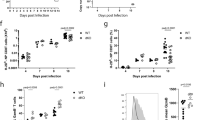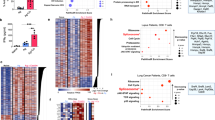Abstract
The NF-κB protein RelB controls dendritic cell (DC) maturation and may be targeted therapeutically to manipulate T cell responses in disease. Here we report that RelB promoted DC activation not as the expected RelB-p52 effector of the noncanonical NF-κB pathway, but as a RelB-p50 dimer regulated by canonical IκBs, IκBα and IκBɛ. IκB control of RelB minimized spontaneous maturation but enabled rapid pathogen-responsive maturation. Computational modeling of the NF-κB signaling module identified control points of this unexpected cell type–specific regulation. Fibroblasts that we engineered accordingly showed DC-like RelB control. Canonical pathway control of RelB regulated pathogen-responsive gene expression programs. This work illustrates the potential utility of systems analyses in guiding the development of combination therapeutics for modulating DC-dependent T cell responses.
This is a preview of subscription content, access via your institution
Access options
Subscribe to this journal
Receive 12 print issues and online access
$209.00 per year
only $17.42 per issue
Buy this article
- Purchase on Springer Link
- Instant access to full article PDF
Prices may be subject to local taxes which are calculated during checkout






Similar content being viewed by others
Accession codes
References
Banchereau, J. & Steinman, R.M. Dendritic cells and the control of immunity. Nature 392, 245–252 (1998).
Liu, Y.J. IPC: professional type 1 interferon-producing cells and plasmacytoid dendritic cell precursors. Annu. Rev. Immunol. 23, 275–306 (2005).
Serbina, N.V., Salazar-Mather, T.P., Biron, C.A., Kuziel, W.A. & Pamer, E.G. TNF/iNOS-producing dendritic cells mediate innate immune defense against bacterial infection. Immunity 19, 59–70 (2003).
Steinman, R.M. & Banchereau, J. Taking dendritic cells into medicine. Nature 449, 419–426 (2007).
Carrasco, D., Ryseck, R.P. & Bravo, R. Expression of relB transcripts during lymphoid organ development: specific expression in dendritic antigen-presenting cells. Development 118, 1221–1231 (1993).
Zanetti, M., Castiglioni, P., Schoenberger, S. & Gerloni, M. The role of relB in regulating the adaptive immune response. Ann. NY Acad. Sci. 987, 249–257 (2003).
Li, M. et al. Immune modulation and tolerance induction by RelB-silenced dendritic cells through RNA interference. J. Immunol. 178, 5480–5487 (2007).
Wu, L. et al. RelB is essential for the development of myeloid-related CD8α- dendritic cells but not of lymphoid-related CD8α+ dendritic cells. Immunity 9, 839–847 (1998).
Kobayashi, T. et al. TRAF6 is a critical factor for dendritic cell maturation and development. Immunity 19, 353–363 (2003).
Hofmann, J., Mair, F., Greter, M., Schmidt-Supprian, M. & Becher, B. NIK signaling in dendritic cells but not in T cells is required for the development of effector T cells and cell-mediated immune responses. J. Exp. Med. 208, 1917–1929 (2011).
Yang, H. et al. Suppression of ongoing experimental autoimmune myasthenia gravis by transfer of RelB-silenced bone marrow dentritic cells is associated with a change from a T helper Th17/Th1 to a Th2 and FoxP3+ regulatory T-cell profile. Inflamm. Res. 59, 197–205 (2010).
Pomerantz, J.L. & Baltimore, D. Two pathways to NF-κB. Mol. Cell 10, 693–695 (2002).
Oeckinghaus, A., Hayden, M.S. & Ghosh, S. Crosstalk in NF-κB signaling pathways. Nat. Immunol. 12, 695–708 (2011).
Derudder, E. et al. RelB/p50 dimers are differentially regulated by tumor necrosis factor-alpha and lymphotoxin-beta receptor activation: critical roles for p100. J. Biol. Chem. 278, 23278–23284 (2003).
Lind, E.F. et al. Dendritic cells require the NF-κB2 pathway for cross-presentation of soluble antigens. J. Immunol. 181, 354–363 (2008).
O'Sullivan, B.J. & Thomas, R. CD40 ligation conditions dendritic cell antigen-presenting function through sustained activation of NF-κB. J. Immunol. 168, 5491–5498 (2002).
Saccani, S., Pantano, S. & Natoli, G. Modulation of NF-κB activity by exchange of dimers. Mol. Cell 11, 1563–1574 (2003).
Ammon, C., Mondal, K., Andreesen, R. & Krause, S.W. Differential expression of the transcription factor NF-κB during human mononuclear phagocyte differentiation to macrophages and dendritic cells. Biochem. Biophys. Res. Commun. 268, 99–105 (2000).
Gasparini, C., Foxwell, B.M. & Feldmann, M. RelB/p50 regulates CCL19 production, but fails to promote human DC maturation. Eur. J. Immunol. 39, 2215–2223 (2009).
Basak, S., Shih, V.F. & Hoffmann, A. Generation and activation of multiple dimeric transcription factors within the NF-κB signaling system. Mol. Cell. Biol. 28, 3139–3150 (2008).
Basak, S. et al. A fourth IκB protein within the NF-κB signaling module. Cell 128, 369–381 (2007).
Shih, V.F. et al. Kinetic control of negative feedback regulators of NF-κB/RelA determines their pathogen- and cytokine-receptor signaling specificity. Proc. Natl. Acad. Sci. USA 106, 9619–9624 (2009).
Li, T. et al. MicroRNAs modulate the noncanonical transcription factor NF-κB pathway by regulating expression of the kinase IKKα during macrophage differentiation. Nat. Immunol. 11, 799–805 (2010).
Wuerzberger-Davis, S.M. et al. Nuclear export of the NF-κB inhibitor IκBα is required for proper B cell and secondary lymphoid tissue formation. Immunity 34, 188–200 (2011).
Shih, V.F., Tsui, R., Caldwell, A. & Hoffmann, A. A single NFκB system for both canonical and non-canonical signaling. Cell Res. 21, 86–102 (2011).
Waterfield, M., Jin, W., Reiley, W., Zhang, M. & Sun, S.C. IκB kinase is an essential component of the Tpl2 signaling pathway. Mol. Cell. Biol. 24, 6040–6048 (2004).
He, J.Q. et al. Rescue of TRAF3-null mice by p100 NF-κB deficiency. J. Exp. Med. 203, 2413–2418 (2006).
Hoffmann, A., Natoli, G. & Ghosh, G. Transcriptional regulation via the NF-κB signaling module. Oncogene 25, 6706–6716 (2006).
Bonizzi, G. et al. Activation of IKKα target genes depends on recognition of specific κB binding sites by RelB:p52 dimers. EMBO J. 23, 4202–4210 (2004).
Lernbecher, T., Kistler, B. & Wirth, T. Two distinct mechanisms contribute to the constitutive activation of RelB in lymphoid cells. EMBO J. 13, 4060–4069 (1994).
Dobrzanski, P., Ryseck, R.P. & Bravo, R. Differential interactions of Rel-NF-κB complexes with IκBα determine pools of constitutive and inducible NF-κB activity. EMBO J. 13, 4608–4616 (1994).
Fusco, A.J. et al. NF-κB p52:RelB heterodimer recognizes two classes of κB sites with two distinct modes. EMBO Rep. 10, 152–159 (2009).
Moorthy, A.K., Huang, D.B., Wang, V.Y., Vu, D. & Ghosh, G. X-ray structure of a NF-κB p50/RelB/DNA complex reveals assembly of multiple dimers on tandem κB sites. J. Mol. Biol. 373, 723–734 (2007).
Weih, F., Warr, G., Yang, H. & Bravo, R. Multifocal defects in immune responses in RelB-deficient mice. J. Immunol. 158, 5211–5218 (1997).
Sasaki, C.Y., Ghosh, P. & Longo, D.L. Recruitment of RelB to the Csf2 promoter enhances RelA-mediated transcription of granulocyte-macrophage colony-stimulating factor. J. Biol. Chem. 286, 1093–1102 (2011).
Bergqvist, S. et al. Kinetic enhancement of NF-κBxDNA dissociation by IκBα. Proc. Natl. Acad. Sci. USA 106, 19328–19333 (2009).
Werner, S.L., Barken, D. & Hoffmann, A. Stimulus specificity of gene expression programs determined by temporal control of IKK activity. Science 309, 1857–1861 (2005).
O'Dea, E.L., Kearns, J.D. & Hoffmann, A. UV as an amplifier rather than inducer of NF-κB activity. Mol. Cell 30, 632–641 (2008).
O'Dea, E.L. et al. A homeostatic model of IκB metabolism to control constitutive NF-κB activity. Mol. Syst. Biol. 3, 111 (2007).
Kearns, J.D., Basak, S., Werner, S.L., Huang, C.S. & Hoffmann, A. IκBepsilon provides negative feedback to control NF-κB oscillations, signaling dynamics, and inflammatory gene expression. J. Cell Biol. 173, 659–664 (2006).
Hoffmann, A., Levchenko, A., Scott, M.L. & Baltimore, D. The IκB-NF-κB signaling module: temporal control and selective gene activation. Science 298, 1241–1245 (2002).
Lutz, M.B. et al. An advanced culture method for generating large quantities of highly pure dendritic cells from mouse bone marrow. J. Immunol. Methods 223, 77–92 (1999).
Boonstra, A. et al. Flexibility of mouse classical and plasmacytoid-derived dendritic cells in directing T helper type 1 and 2 cell development: dependency on antigen dose and differential toll-like receptor ligation. J. Exp. Med. 197, 101–109 (2003).
Cheng, C.S. et al. The specificity of innate immune responses is enforced by repression of interferon response elements by NF-κB p50. Sci. Signal. 4, ra11 (2011).
Sasik, R., Woelk, C.H. & Corbeil, J. Microarray truths and consequences. J. Mol. Endocrinol. 33, 1–9 (2004).
Tusher, V.G., Tibshirani, R. & Chu, G. Significance analysis of microarrays applied to the ionizing radiation response. Proc. Natl. Acad. Sci. USA 98, 5116–5121 (2001).
Saeed, A.I. et al. TM4 microarray software suite. Methods Enzymol. 411, 134–193 (2006).
Acknowledgements
We thank Z. Tao and G. Ghosh (University of California San Diego) for plasmids and recombinant proteins, S. Basak, A. Wu, P. Loriaux, R. Tsui for computational modeling advice, and C. Brown and M. Karin (University of California San Diego) for Traf3−/− embryos. This study was supported by GM085763 (A.H.), GM071573 (A.H.), AI090935 (A.H.), GM085325 (J.P.) and AI081923 (E.I.Z.).
Author information
Authors and Affiliations
Contributions
V.F.-S.S. and A.H. designed the study. V.F.-S.S. and M.M. carried out all experimental work with assistance from J.Q.H., T.Y., R.F. and M.A., and guidance from E.I.Z. and A.H. J.D.-T. and J.D.K. carried out the computational modeling work and J.P. the bioinformatic analysis. V.F.-S.S. and A.H. wrote the manuscript with contributions from all authors.
Corresponding author
Ethics declarations
Competing interests
The authors declare no competing financial interests.
Supplementary information
Supplementary Text and Figures
Supplementary Figures 1–6, Supplementary Tables 1–3, Supplementary Note (PDF 2909 kb)
Rights and permissions
About this article
Cite this article
Shih, VS., Davis-Turak, J., Macal, M. et al. Control of RelB during dendritic cell activation integrates canonical and noncanonical NF-κB pathways. Nat Immunol 13, 1162–1170 (2012). https://doi.org/10.1038/ni.2446
Received:
Accepted:
Published:
Issue Date:
DOI: https://doi.org/10.1038/ni.2446
This article is cited by
-
TRAF3 activates STING-mediated suppression of EV-A71 and target of viral evasion
Signal Transduction and Targeted Therapy (2023)
-
NF-κB in control of regulatory T cell development, identity, and function
Journal of Molecular Medicine (2022)
-
ASB2 is a direct target of FLI1 that sustains NF-κB pathway activation in germinal center-derived diffuse large B-cell lymphoma
Journal of Experimental & Clinical Cancer Research (2021)
-
A T cell-intrinsic function for NF-κB RelB in experimental autoimmune encephalomyelitis
Scientific Reports (2021)
-
Apigenin Modulates Dendritic Cell Activities and Curbs Inflammation Via RelB Inhibition in the Context of Neuroinflammatory Diseases
Journal of Neuroimmune Pharmacology (2021)



